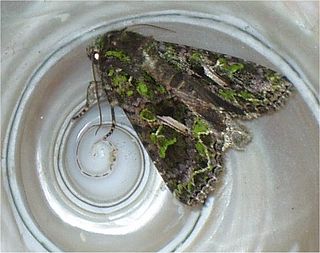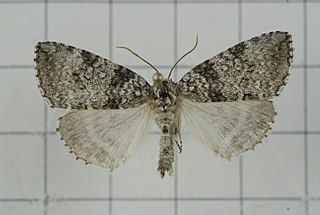
Lepidoptera is an order of insects that includes butterflies and moths. About 180,000 species of the Lepidoptera are described, in 126 families and 46 superfamilies, 10 percent of the total described species of living organisms. It is one of the most widespread and widely recognizable insect orders in the world. The Lepidoptera show many variations of the basic body structure that have evolved to gain advantages in lifestyle and distribution. Recent estimates suggest the order may have more species than earlier thought, and is among the four most species-rich orders, along with the Hymenoptera, Diptera, and Coleoptera.

Moths are a group of insects that includes all members of the order Lepidoptera that are not butterflies. They were previously classified as suborder Heterocera, but the group is paraphyletic with respect to butterflies and neither subordinate taxa are used modern classifications. Moths make up the vast majority of the order. There are thought to be approximately 160,000 species of moth, many of which have yet to be described. Most species of moth are nocturnal, but there are also crepuscular and diurnal species.

The domestic silk moth is an insect from the moth family Bombycidae. It is the closest relative of Bombyx mandarina, the wild silk moth. The silkworm is the larva or caterpillar of a silk moth. It is an economically important insect, being a primary producer of silk. A silkworm's preferred food are white mulberry leaves, though they may eat other mulberry species and even the osage orange. Domestic silk moths are entirely dependent on humans for reproduction, as a result of millennia of selective breeding. Wild silk moths are not as commercially viable in the production of silk.

The de Havilland Aircraft Company Limited was a British aviation manufacturer established in late 1920 by Geoffrey de Havilland at Stag Lane Aerodrome Edgware on the outskirts of north London. Operations were later moved to Hatfield in Hertfordshire.

Attacus atlas, the Atlas moth, is a large saturniid moth endemic to the forests of Asia. The species was first described by Carl Linnaeus in his 1758 10th edition of Systema Naturae.

The buff ermine is a moth of the family Erebidae. It is sometimes placed in the genus Spilosoma. The species was first described by Johann Siegfried Hufnagel in 1766. It is found throughout the temperate belt of the Palearctic region south to northern Turkey, Georgia, Kazakhstan, southern Siberia, eastern Mongolia, Amur Region, China, Korea and Japan.

Rev William Jacob Holland FRSE LLD was the eighth Chancellor of the University of Pittsburgh (1891–1901) and Director of the Carnegie Museums of Pittsburgh. He was an accomplished lepidopterist, zoologist, and paleontologist, as well as an ordained Presbyterian minister.

The de Havilland DH.60 Moth is a 1920s British two-seat touring and training aircraft that was developed into a series of aircraft by the de Havilland Aircraft Company.

Gracillariidae is an important family of insects in the order Lepidoptera and the principal family of leaf miners that includes several economic, horticultural or recently invasive pest species such as the horse-chestnut leaf miner, Cameraria ohridella.

The DH.83 Fox Moth was a successful small biplane passenger aircraft from the 1930s powered by a single de Havilland Gipsy Major I inline inverted engine, manufactured by the de Havilland Aircraft Company.

Copromorphidae, the "tropical fruitworm moths", is a family of insects in the lepidopteran order. These moths have broad, rounded forewings, and well-camouflaged scale patterns. Unlike Carposinidae the mouthparts include "labial palps" with the second rather than third segment the longest. With other unusual structural characteristics of the caterpillar and adult, it could represent the sister lineage of all other extant members of this superfamily. The genus Sisyroxena from Madagascar is also notable for its unusual venation and wing scale sockets.

Oncocera semirubella is a small moth of the family Pyralidae. It is found in European regions, including the British Isles, and East Asia.

The Orache Moth(Trachea atriplicis) is a species of moth of the family Noctuidae. It is found in all of Europe, east across the Palearctic to the Pacific Ocean and Japan.

Udea ferrugalis, the rusty dot pearl, is a moth of the family Crambidae. The species was first described by Jacob Hübner in 1796.

Cephonodes hylas, the coffee bee hawkmoth, pellucid hawk moth or coffee clearwing, is a moth of the family Sphingidae. The species was first described by Carl Linnaeus in 1771. A widely distributed moth, it is found in the Near East, Middle East, Africa, India, Sri Lanka, Japan, Southeast Asia and Australia.

Argyresthia conjugella, the apple fruit moth, is a moth of the family Yponomeutidae. It is found in North America, Europe, Siberia, Central Asia and Japan.

Dichomeridinae is a subfamily of moths in the family Gelechiidae.

Hipoepa fractalis is a species of moth of the family Noctuidae first described by Achille Guenée in 1854. It is found in Taiwan, China, Japan, Kenya, Korea, India, Malaysia, Nigeria, Indonesia, the Philippines, Thailand, Cape Verde, Réunion, Saudi Arabia, South Africa, Sri Lanka, Uganda, Yemen and Australia.

Gracillariinae are a subfamily of moths which was described by Henry Tibbats Stainton in 1854.

Parapsestis argenteopicta is a moth in the family Drepanidae. It was described by Oberthür in 1879. It is found in the Russian Far East, Korea, Japan, Taiwan, western, north-eastern, northern and central China and Nepal. The habitat consists of various types of mixed forests and oak woods.



















